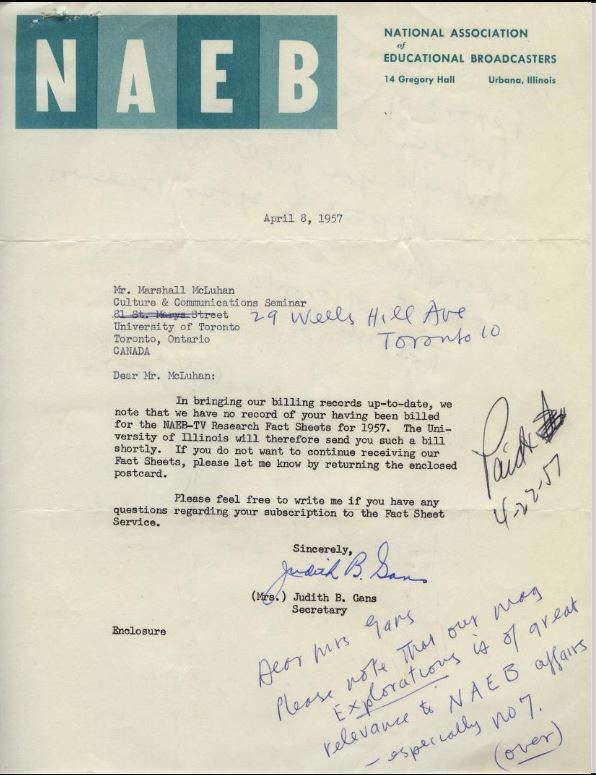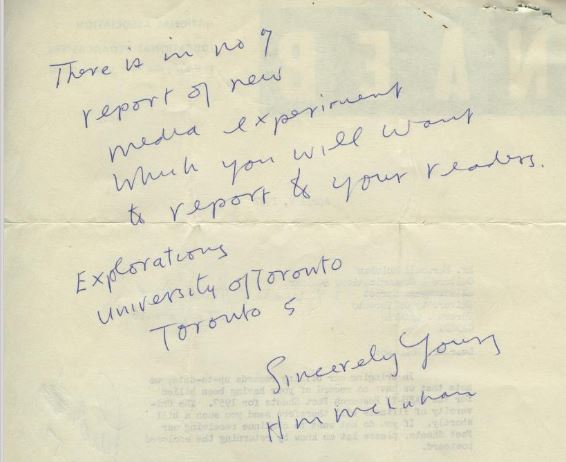McLuhan’s work with the National Association of Educational Broadcasters in the late 1950’s was central to his subsequent career and fame. But the first personal contact he had with the organization1 may have been a seemingly inconsequential billing reminder, dated April 8, 1957, that he received from the NAEB secretary, Judith Gans.
McLuhan appears to have returned the Gans reminder correcting the address it had for him, and presumably enclosing his payment, with the following handwritten note:2
Dear Mrs Gans,
Please note that our mag Explorations is of great relevance to NAEB affairs — especially no7.
There is in no7 report of new media experiment which you will want to report to your readers.
Explorations
University of Toronto
Toronto 5
Sincerely yours
H M McLuhan
McLuhan’s reference in Explorations 7 must have been to ‘The New Languages’, pages 4-21, which lists McLuhan’s close friend, Edmund (Ted) Carpenter, as its author at its end.3 The “media experiment” is reported on pages 16-21. But this essay had previously been published in the Chicago Review4 and there McLuhan was listed as Carpenter’s co-author. Indeed, much of the language of the paper plainly stems from McLuhan.
McLuhan’s “scrawled” note was remembered by Harry Skornia over 30 years later5 as igniting the intense collaboration the two would come to have over the next 4 or 5 years.6 With it, McLuhan had correctly sensed the felt need within the NAEB community for a ‘scientific basis’ to ground its commitment to new media in education.7
- But see McLuhan’s handwritten letter to Harry Skornia from August 20, 1957, which may indicate an earlier contact. The letter and discussion of it are given in NAEB seminar December 1957. ↩
- The Gans letter with its McLuhan note is preserved in the NAEB archive that is steadily being posted to the internet in the great Unlocking the Airwaves project. ↩
- Unlike other issues of Explorations, there is no Table of Contents for #7. ↩
- ‘The New Languages’, Chicago Review, 10:1, Spring, 1956, 46-52. ↩
- Skornia recalled the note in an interview reported in ‘The Cradle of PBS‘ by Jerry Landay (Illinois Quarterly, 3:1, Winter 1991, 35 – 41). For discussion see McLuhan and Skornia 1957. ↩
- The two then remained in correspondence until McLuhan’s death. ↩
- As reported by Josh Shepperd in ‘Medien miss-verstehen. Marshall McLuhan und die National Association of Educational Broadcasters, 1958-1960‘ (Zeitschrift für Medienwissenschaft, 3:5:2 (2011), 25–43), there was a great gulf between how McLuhan and many members of the NAEB, not least its research committee, understood ‘scientific basis’ (with Harry Skornia caught in the middle between the two sides). For the committee members, the procedures of science were already well known and the need was to apply them to media, especially radio and television, as these might be deployed in education. For McLuhan, in fundamental contrast, the initiation of a scientific investigation of media (dual genitive!) would necessarily require the sort of revolutionary Gestalt-switch as seen in the advent of writing in 5th century Athens: “Writing is the translation of the audible into the visible. The translation is literally, metaphor. Recorded history is thus set upon a metaphor” (‘Space, Time, and Poetry’, Explorations 4, 1955). Now Shepperd recognizes the sharp difference between these views of ‘scientific basis’ and sets it out neatly in the concluding remarks of his paper: “Nur selten in der Wissenschaftsgeschichte kommen zwei wichtige paradigmatische Impulse so eng miteinander in Berührung und scheitern doch daran, eine echte dialektische Wechselwirkung einzugehen. (…) Eher als in einem Verhältnis der wechselseitigen Beeinflussung aber verhielten sie sich zueinander in einem Verhältnis der wechselseitigen Abstoßung.” (43) For McLuhan, however, such a gap was no “Scheitern” or “wechselseitige Abstoßung”, or it was not only these, but instead was an indication of the elementary structure of media in general: “the gap where the action is”. Indeed, this was precisely the spine-tingling discovery he reported to Skornia in December 1958 in terms of the contrast between light on and light through. While light on had dominated history for 2500 years and produced the entire world as we know it, including the notion of science of the NAEB research committee, as well as Shepperd’s “echte dialektische Wechselwirkung”, it could now, with the electric revolution, be recognized as only (only!) a remarkable species of the genus of light through. As McLuhan would spend the rest of his life upacking, the utterly transformative movement backwards and downwards from the former to the latter was exactly what was at stake in Understanding Media. ↩

